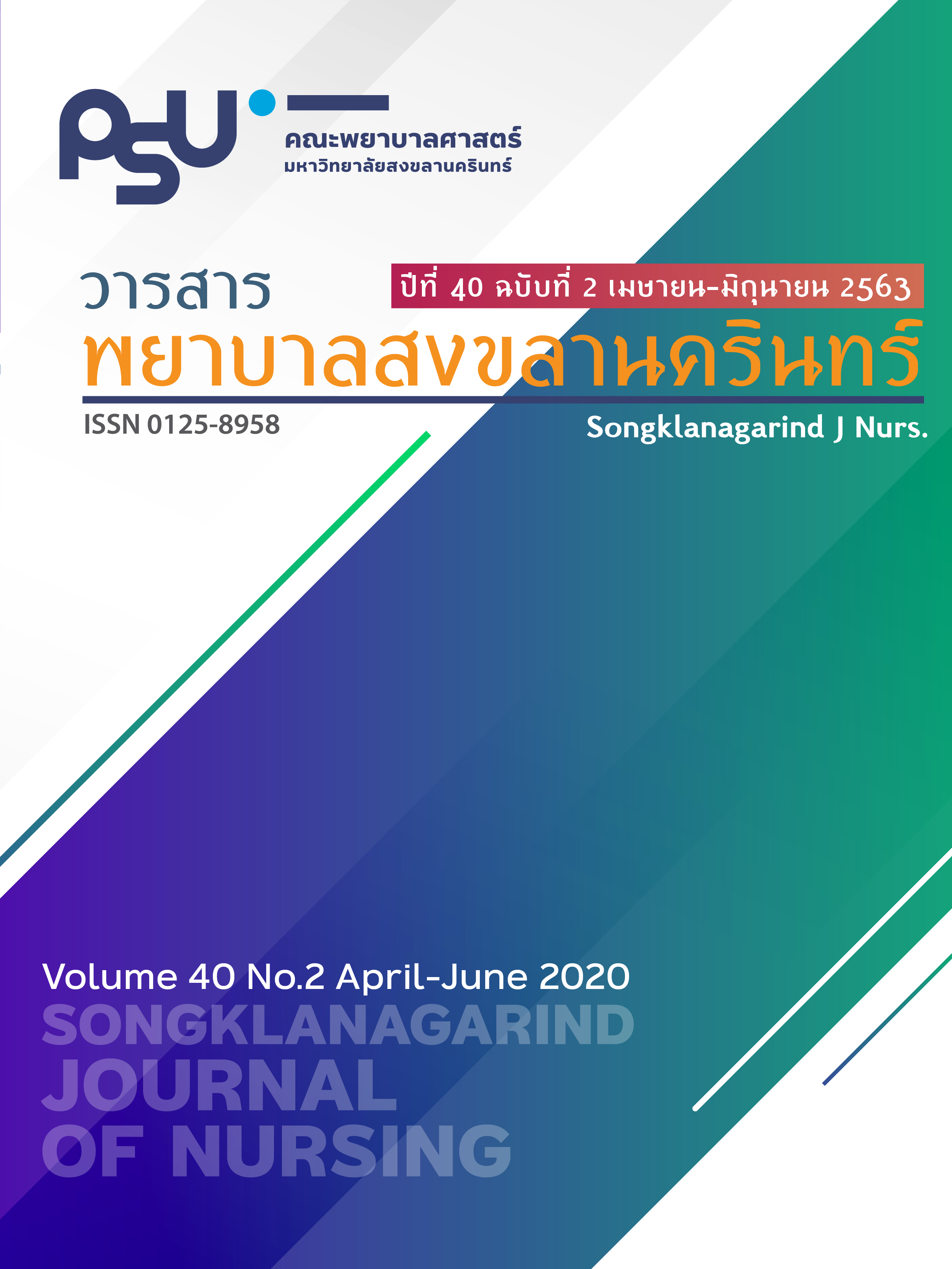การพัฒนารูปแบบบริการสุขภาพเพื่อป้องกันโรคหลอดเลือดสมอง ในผู้ใช้บริการโรคเรื้อรังที่มีความเสี่ยงต่อการเกิดโรคหัวใจ และหลอดเลือดในบริบทการบริการสุขภาพปฐมภูมิ
Main Article Content
บทคัดย่อ
การวิจัยเชิงปฏิบัติการมีวัตถุประสงค์เพื่อพัฒนารูปแบบบริการสุขภาพป้องกันโรคหลอดเลือดสมองในผู้ใช้บริการโรคเรื้อรังที่มีความเสี่ยงต่อการเกิดโรคหัวใจและหลอดเลือดในบริบทการบริการสุขภาพปฐมภูมิ ผู้ร่วมวิจัย เป็นตัวแทนจาก 3 กลุ่ม ผู้มีส่วนเกี่ยวข้องในการบริการสุขภาพปฐมภูมิ คือ กลุ่มผู้ใช้บริการ 18 คน กลุ่มบุคลากรสุขภาพ 9 คน และกลุ่มผู้ที่มีส่วนเกี่ยวข้องอื่นๆ 9 คน เก็บรวบรวมข้อมูลเชิงคุณภาพโดยการสัมภาษณ์เชิงลึกและการสนทนากลุ่ม เก็บรวบรวมข้อมูลเชิงปริมาณโดยใช้แบบประเมินความเสี่ยงต่อการเกิดโรคหัวใจและหลอดเลือดสมอง การศึกษาแบ่งเป็น 3 ระยะ ได้แก่ ระยะวิเคราะห์สถานการณ์ ระยะพัฒนาการดำเนินงาน และระยะสังเคราะห์รูปแบบ วิเคราะห์ข้อมูลเชิงคุณภาพด้วยวิธีการวิเคราะห์เนื้อหาและวิเคราะห์ข้อมูลเชิงปริมาณด้วยสถิติเชิงพรรณนา ผลการศึกษา เกิดรูปแบบการบริการสุขภาพเพื่อป้องกันโรคหลอดเลือดสมองแบบบูรณาการ โดยมี 5 ขั้นตอนบริการ คือ 1) การส่งเสริมการปรับเปลี่ยนพฤติกรรมกลุ่มเสี่ยงโรคเรื้อรัง 2) การบริการคลินิกโรคเรื้อรังแบบบูรณาการ 3) การบริการช่องทางด่วนโรคหลอดเลือดสมอง 4) การบริการฟื้นฟูสภาพอย่างต่อเนื่อง และ 5) การเยี่ยมบ้านและดูแลระยะยาว
สรุป รูปแบบที่เกิดจากระบวนการพัฒนาเป็นบริการแบบบูรณาการระหว่างการบริการสุขภาพโรคหลอดเลือดสมองและการบริการด้านสังคม
Article Details
เอกสารอ้างอิง
Bureau of non-communicable disease, Ministry of Public Health. 5-Year National NCDs prevention and control strategic and action plan (2017-2021); 2017. Thai.
Strategy and Planning Division Ministry of Public Health. Statistical Thailand; 2017. Thai.
International health policy program. Thailand burden of disease 2011. Thai health promotion foundation; 2014. Thai.
Mahasarakham provincial public health office. Illness with non-communicable disease of kaedum contracting unit for primary care; 2015. Thai.
World Stroke Organization. World stroke day 2016. [Internet]. [Cited 2017 May 6]. Available from: http://www.worldstrokecampaign.org/get- involved/world-stroke-day.html
Sriprasert P. Service plan health area 7. Major chronic non-communicable diseases (NCD), Health area7; 2013. Thai.
Intolo S, Sritanyarat W. Health care service for older persons with stroke: Focusing on prevention or cure. Journal of Nursing Science and Health. 2016; 39(4): 22-32. Thai.
Limwattananon C, Tiamkoa S, Waleekhachonloet O, et al. Differences in stroke care and outcomes across health insurance schemes: a quantitative analysis. Health system research institute, Bangkok, 2014. Thai.
Bureau of Epidemiology, Department of disease control, Ministry of public health. Chronic diseases surveillance report. Bangkok, 2012. Thai.
National stroke foundation. Acute stroke services framework 2011. [Internet]. [cited 2017 Dec 6]. Available from http://strokefoundation. com.au/site/media/Acute_Stroke_Framework_ Services_2011.pdf
Okamoto E, Miyamoto M, Hara K, et al. Integrated care through disease-oriented clinical care pathways: experience from Japan’s regional health planning initiatives. Int J Integr Care. 2011; 11(Spec 10 th Anniversary Ed): e125.
Kemmis S, McTaggart R. Participatory action research: Communicative action and the public sphere. In N. Denzin & Y. Lincoln, Eds. Handbook of qualitative research. 3 rd ed. Thousand Oaks: Sage; 2005. p. 559-604.
Bureau of non-communicable diseases. Department of disease control, Thailand Ministry of Public Health. Guidelines for risk assessment of cardiovascular disease. 3 rd ed. Bangkok; 2016. Thai.
Chuenjairuang P, Sritanyarat W. Development of primary health care services for stroke prevention in persons with warning signs of stroke. Pacific Rim Int J Nurs Res. 2012; 16(4): 313-25.
Sukhumanpitak J, Nantsupawat W, Hornboonherm P. Development of a care model for male stroke patients in secondary hospital using a participatory action research. Nurs’ Assoc Thailand, North-Eastern Divis. 2012; 30(1): 32-8. Thai.
Baokumphai Y, Jongudomkarn D. Effects of the “Kumpavapee model” toward the potential development of the family leaders in prevention, caring, and rehabilitation of stroke patients in community: case study at the Khon Kaen hospital, KKU Research Journal of Humanities and Social Sciences (Graduate Studies). 2013; 13(4): 122-34. Thai.
Nuntaboot K. Community health care system: concept, design and tools. Nonthaburi: Thailand Nursing System Research Institute. Bangkok; 2008. Thai.
Thangkratok P. The role of the nurses in the chronic disease management. Songklanagarind J Nurs. 2017; 37(2): 154-59. Thai.


